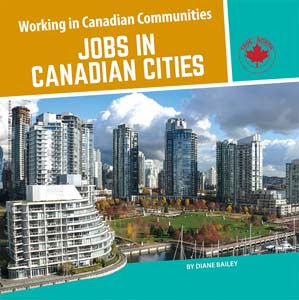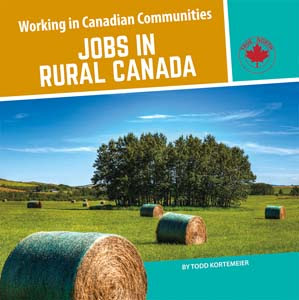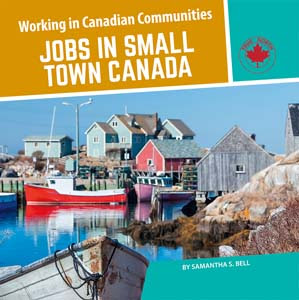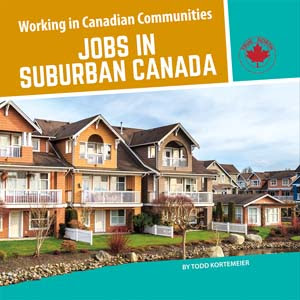| ________________
CM . . .
. Volume XXIII Number 23. . . February 24, 2017
excerpt:
Four titles comprise the “Working in Canadian Communities” series, each of them consisting of four or five chapters. They begin with a brief explanation of the characteristics of the specific setting, followed by information about the predominant job categories found there. Throughout the books, there are examples from different parts of Canada, some of which include Winnipeg’s textile industry (manufacturing), the Alberta oil sands’ gas and oil industry (energy development) and the Okanagan Valley’s fruit orchards (farming). The body of the text is written in short sentences that are easy for youngsters to comprehend. Text boxes provide additional facts, an example of which is that Saskatchewan has the largest amount of farmland in the country and is known as “Canada’s Breadbasket”, with 42,000 people involved in farming in that province. Each title also has an Inquiry Question which invites readers to reflect upon some of the concepts and to compare their experiences with those of people living in other types of communities. Generally speaking, the colour photographs match the text, although there are a few instances where a more suitable photo could have been chosen. For example, in one case, the text is describing work on a car assembly line, but the accompanying photograph shows the exterior of a concrete factory; in another case, the topic is jobs on a farm, but the photo merely shows the farm house and a large garage- and not even any distinguishing farm-type buildings, such as a silo or a barn, nor does it show farmers at work. And, though young readers will likely not even notice, the map which appears at the end of each book has a scale of one centimeter = 0.5 kilometer. The graphics on the map, depicting houses, factories, farms and forests, add to the map’s visual appeal, but they are not drawn to scale, so readers are looking at two-storey houses, which, had they been drawn to scale, would be a half-kilometer wide in reality, evergreen trees that would be 1.5 km tall, and factories that would be three km wide and four km high. Perhaps it would have been better just to omit the scale altogether. A table of contents, a glossary, an index and a short list of books and websites for further study are included. Two-thirds of Canadians live in cities. Many of these cities have factories for converting raw materials from natural resources and farms to manufactured goods and processed foods, and also serve as trucking hubs or ports for shipping these goods to other parts of Canada and the world. Jobs in Canadian Cities also examines high tech companies which manufacture medicine and medical devices, communication equipment and software. An interesting fact is that Canada is the third largest producer of video games in the world, with Vancouver alone being home to 170 video game companies. Other topics in this title include jobs in the trades, the service industry and the arts. Many of the arts-related professions (actors, musicians, artists and dancers) as well as venues to showcase their work (theatres, galleries and museums) are located in cities. Jobs in Rural Canada highlights careers in areas of the country that have fewer than 1,000 inhabitants or less than 400 people per square kilometer. Natural resource jobs include those related to forestry (biologists, loggers, truckers, mechanics, saw mill and paper mill workers) with most of the them located in British Columbia, Quebec and Ontario. Farming jobs are associated with various types of crops and livestock, dairy and egg farming, and veterinary care. Rural areas, by virtue of their wide open spaces, have plenty of room for manufacturing plants. Energy production is also found in rural areas. Canada is the world’s fifth largest producer of oil and employs hundreds of thousands of people in the oil industry. Some examples of energy-related occupations include drillers, pipeline workers, scientists, engineers, site managers, truckers and equipment maintenance staff. Small towns usually have less than 10,000 residents. In Jobs in Small Town Canada, readers will learn about the many advantages of living in a small town. These range from a slower pace of life to a quieter environment and cheaper land prices. This title discusses opportunities for small businesses, service professions, tourism and the retail sector. Of course, depending on a town’s location, there are often occupations that are not available anywhere else. For example, in a town located on a coast there are fishers, seafood vendors and boat builders, while in a town located near a forest there are job opportunities for loggers, carpenters and paper mill workers. Finally, Jobs in Suburban Canada explains that a suburb is more spread out than a city, usually has no downtown area or tall office buildings, and is characterized by more homes and fewer businesses. (One discrepancy found in this title: the text states that two-thirds of Canadians live in suburbs, yet the title about cities says the very same thing about cities. Which statement is accurate?) In the suburbs, the emphasis is on jobs related to manufacturing (auto assembly line workers, forklift operators, shippers, warehouse workers and truckers), the construction industry (architects, roofers, painters, carpenters, plumbers, electricians and realtors) and the service industry (health care workers and educators). Though there is some repetition among the titles, the series does quite a good job of explaining the various types of occupations in different settings. The price of the books, however, is steep for only 18 pages of actual information. Since most of the photographs take up an entire page and the map is a double-page spread, only eight or nine pages are devoted to text in each title. Recommended with Reservations. Gail Hamilton is a former teacher-librarian in Winnipeg, MB.
To comment
on this title or this review, send mail to cm@umanitoba.ca.
Copyright © the Manitoba Library Association. Reproduction for personal
use is permitted only if this copyright notice is maintained. Any
other reproduction is prohibited without permission.
Next Review | Table of Contents For This Issue -February 24, 2017 |



